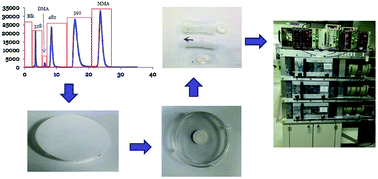SI traceable determination of arsenic species in kelp (Thallus laminariae)†
Abstract
A dietary supplement, kelp contains a significant amount of arsenic that is mostly arsenosugars. The determination of arsenosugars is difficult due to a lack of arsenosugar calibration standard, because arsenosugar compounds are not commercially available. This work reports the determination of arsenicals in a kelp extract with traceability to the International System of Units (SI). The hydrophilic fraction of arsenicals was reproducibly extracted from a candidate Standard Reference Material® (SRM) 3232 Kelp Powder (Thallus Laminariae) in development at the National Institute of Standards and Technology (NIST). Arsenosugars and dimethylarsinic acid (DMA) were separated into fractions using analytical liquid chromatography (LC) cation and anion columns. The arsenic in the fractions was determined using instrumental neutron activation analysis (INAA). Cation exchange separation was used for INAA determination of arsenosugar 3-[5′-deoxy-5′-(dimethylarsinoyl)-β-ribofuranosyloxy]propylene glycol (As(328)) for the first time, while DMA and arsenosugars 3-[5′-deoxy-5′-(dimethylarsinoyl)-β-ribofuranosyloxy]-2-hydroxypropyl 2,3-dihydroxypropyl hydrogen phosphate (As(482)) and 3-[5′-deoxy-5′-(dimethylarsinoyl)-β-ribofuranosyloxy]-2-hydroxypropanesulfonic acid (As(392)) were determined following anion exchange separation. The contents of DMA, As(328), As(482), and As(392) were 0.41 mg kg−1 ± 0.09 mg kg−1, 1.10 mg kg−1 ± 0.25 mg kg−1, 5.23 mg kg−1 ± 0.46 mg kg−1, and 13.17 mg kg−1 ± 0.67 mg kg−1, respectively. Separately, components of arsenic species in the kelp extract including DMA, As(328), and inorganic arsenic were determined using LC-inductively coupled plasma mass spectrometry. The results of DMA and As(328) were 0.485 mg kg−1 ± 0.024 mg kg−1 and 1.14 mg kg−1 ± 0.03 mg kg−1, respectively, which were in good agreement with those determined by INAA in fractions of LC eluent. The most toxic species, AsIII and AsV, were found to be <0.07 mg kg−1 and 0.231 mg kg−1 ± 0.018 mg kg−1, respectively. The results were traceable to SI.



 Please wait while we load your content...
Please wait while we load your content...